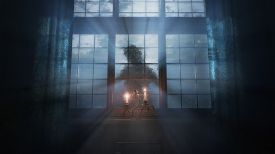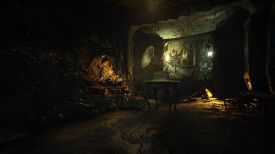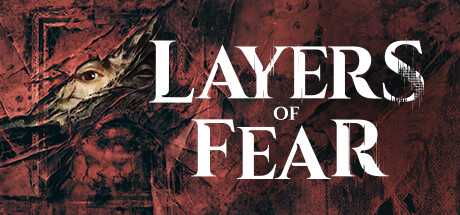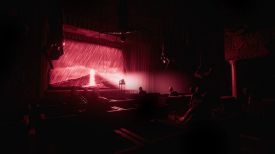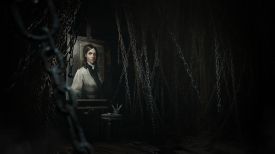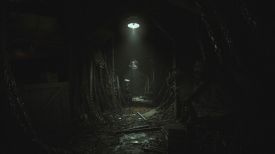|
By flotsam
Layers of Fear (2023)
Bloober Team
You might be familiar with Layers of Fear from several years back, or at
least have heard about it, and in case you might be confused about
exactly what this version is all about, let me explain.
It
consists of remodeled versions of the three previous 'episodes' -
Layers of Fear 1 (the painter), Layers of Fear 2 (the actor) and
Inheritance (the daughter) which was a piece of downloadable content (DLC)
- as well as two new tales, The Writers Story and The Final Note (the
musician). The first of these is an interstitial narrative added to tie
the whole thing together while the musician's story is more like another
piece of DLC.
You start with the writer, who establishes a reason for being where she
is and what she is doing, and you then play the painter's story, the
writer occasionally punctuating the events. Having finished the painter,
the writer will find two books, one for the musician and one for the
daughter. Choose to play one or both of them - having been warned that
you will have to complete the one you start to get back to where you are
- or ignore them and continue as the writer, which once you work out the
trigger will take you to the actor's story.
I played and reviewed the three earlier parts, and thought highly of all
of them. If you want to know a bit more about those parts, check out
those reviews. What follows is based on this single consolidation,
rather than a comparison with what came before, although I may well say
a thing or two along those lines.
The first of which is that while there are changes to the original
games, they are in essence the same games, so if you played them there
will be a degree of familiarity this time around. That said, itís been
four years since the most recent piece and seven since the first, and
despite how much I liked them I havenít played them since. If you are
like me, playing those chapters here will produce a feeling of dťjŗ vu
and a few (or even a few more) ĎI remember thatí moments, but it wonít
detract from the current enjoyment.
One of the first things you will likely notice is how visually sumptuous
the game is. It was always elaborately detailed, but the Unreal engine
upgrade enables it to shine. The sheer amount of detail in the
environments is extraordinary, as are the little bits and pieces. Take
the painter's story as an example; the mansion looks like a mansion
should, albeit one that its occupant has neglected, and it is full of a
lifetimeís worth of stuff. Much of which you can rummage in or look
through, open and close, pick up and examine. Some of that is necessary,
much of it isnít. There will be things to find to move on (keys for
example), other things to collect (drawings and certain personal items)
and lots of notes and letters and the like. It is these written pieces
through which the narrative is told, but other things (like the
drawings) can illuminate that narrative.
The mansion is also chock full of art, not surprisingly given the role
that art in all its forms and guises plays across the whole
construction. Indeed, a particular Ďcharacterí could be said to embody
the creative spark that ebbs and flows, that inspires just as it can
fail to ignite, that is both wonderful and debilitating at various
times. Or perhaps that was just me.
I
did think of all the settings, the mansion was the height of the visual
glory, but itís a comparative thing. The game bristles with good looks
throughout.
I
do love walking around environments like this, which is good considering
how much walking (and running at times) you will do across the five
parts. I confess it felt a little overdone at times (Chapter 3 in the
actorís tale stands out), but that was arguably contributed to by my
relentless effort to push through to the end; consuming big chunks of
some more(ish) of the same does do the game a bit of a disservice. It is
long (at least 20 hours and can well be far longer than that) and taking
a break certainly helped.
It
also encouraged me to slow down a little and explore a bit more
carefully, a key to finding all the collectibles (which isnít essential
but can unlock some Ďsecretí endings) but also to find more of the notes
etc. that will help piece together what is going on. Every note, letter
etc. is like a piece of a puzzle, so the more you find and read the more
complete the picture. You donít carry notes with you but put them back
where you found them, so read it and move on, holding that particular
part in your head and fitting it into what you already know.
I
thought this broken approach to unfolding the tale/s nicely fitted with
the brokenness of much that you come across. If you have to suffer for
your art, then many of the relevant people are virtuosos. Their stories
are lush and personal, and often tragic and terrible. You can uncover
them yourself, but there are connections between them, even without the
writer, who does a reasonable job in terms of her stated intention. The
actorís story felt a little tacked-on, though I think I grasped more of
what it was about this time around, and the other three (painter,
musician and daughter) were effectively cohesive.
Itís a broken environment as well, one that (depending on the part you
are playing) folds back on itself, or morphs into something else
entirely, or behaves almost as if its alive. It can look like what it is
(a house or a ship or a lighthouse) or be nothing like that at all. It
can twitch, or visually shudder back and forth, look normal or somewhere
twisted and even tormented. Visions appear, entities might chase you,
roaring gusts of hot air (or of breath maybe?) threaten to broil you.
Across its parts its an unsettling sometimes supernatural and
occasionally scary space.
Much of the puzzling comes from working your way through these
environments. The game tends to push you forwards but it isnít plain
sailing. You might have to e.g.. find a code to open a combination lock
or more esoterically work out how to make a door appear (not to mention
the key needed to unlock it) by manipulating images projected onto a
wall. Some straight out puzzles might need solving, or a light avoided
in order to pass down a corridor. That the environment changes adds to
the challenge; walk through a door to find yourself facing a brick wall.
Turn and find that the door you came through has gone. Turn back around
and there is now an open door Ė or maybe there isnít - which you walk
through and end up back where you were. Doors open on places they didnít
before, the same place might be in relatively good shape but then
decaying and falling apart the next time, and some places will become
particularly familiar. There are Ďhubsí or just rooms you will come back
to for various reasons (the artists studio is an early one) and it can
pay to get to know these places, especially the configuration of the
more elaborate ones (the rooms on a landing for example). You will also
find your respective collectibles displayed in these places.
There are things that can Ďkillí you, which results in a reset to your
immediate endeavours and you try again. They tend to chase you, so you
can try to just run away, or a light source (a lantern or a torch) can
be used to temporarily disable or destroy it (it will respawn),
depending on the entity. The light source can also be used to animate
mannequins, or dissolve certain spectral echoes, both of which can be
part of moving on.
The light source also does the far more mundane thing of illuminating
the dark places you find yourself, and the musicianís story was mostly
dark (actually and tonally). It also depletes as you use it (a little
bar will show you how it is going), and while it replenishes fairly
quickly, you need a certain amount of illumination available to
successfully use it as a weapon. At its most troublesome you might find
yourself e.g., navigating through a dark dilapidated maze-like attic to
get to the exit door while trying to keep the apparition at bay with a
less than fully charged torch. I failed that particular sequence a fair
few number of times.
Which is where a setting in the options menu can come in handy. In
short, toggling it on means the apparitions canít hurt you, essentially
meaning you can ignore them. I toggled it on to get through the attic,
then turned it back off. It worked a treat, and I used it again
elsewhere.
Turning it off throughout will take some of the tension and excitement
(and fear) out of the proceedings, but not all. It will still scare you
at times, jump or otherwise, and an entity that looked like it came
straight from Silent Hill creeped me out each time it appeared. Toggling
as required is the best way to go in my view, but how you use it is up
to you.
You also shouldnít think these actiony bits dominate in terms of how
frequently they occur. The vast majority of what you do is solitary and
placid. And the fact that you can effectively get rid of them, means you
shouldnít avoid playing because of them.
You do find items and carry them with you (keys mainly), but having them
will cause them to be used so there is no inventory management. The
sounds are as excellent as the visuals, the voice acting more than good,
although the voiceovers of the notes etc. in some stories arenít present
in others. Which was a shame.
The game plays in the first person and uses a combination of mouse and
keyboard. You have full freedom of movement, predominantly steering with
the mouse while using the W key. A small white circle is visible at
hotspots and you use the mouse curser to interact. For things like
opening doors and drawers, turning wheels etc you mimic the appropriate
action with the mouse. I never used to like this but have come to rather
appreciate its immersive qualities.
Some of the things I have mentioned you can change in the settings (no
hotspot markers, no torch bar, turn off voiceovers), including the need
to mimic the action (you can have a button press instead, which can be
helpful if you are running away and have to slide or pull doors). You
can map the keys to suit, and customise other things as well, so make
sure to check them all out. The game saves automatically which only
rarely didnít happen enough to suit me.
There are different endings for each story (but not the writer as far as
I can tell), depending on choices you make, and at least two Ďsecretí
endings provided you found all of certain collectibles. I havenít played
them all, and doubt I would know how to unlock the secret ones if I
hadnít googled. Once you get to the end you can play the various
Chapters within each tale to see if you can unlock different endings. It
remains something for me to do, and will add many more hours to my
endeavours.
I
went into this knowing I would enjoy it and it didnít disappoint. I
would certainly experience it in this configuration, but perhaps piece
by piece rather than in one big block. Itís a richly layered bit of
adventuring, and while I would have edited a sequence here and there (a
search for paints through a maze-like set of corridors comes to mind),
its considerable strengths overwhelmed any quibble I might have had at
various times.
I played on:
OS: Windows
10, 64 Bit
Processor:
Intel i7-9700K 3.7GHz
RAM: Corsair
Dominator Platinum RGB DDR4 32GB
Video card:
AMD Radeon RX 580 8192MB
GameBoomers Review Guidelines
August 2023
design copyright© 2023
GameBoomers
Group
 GB
Reviews Index GB
Reviews Index |

